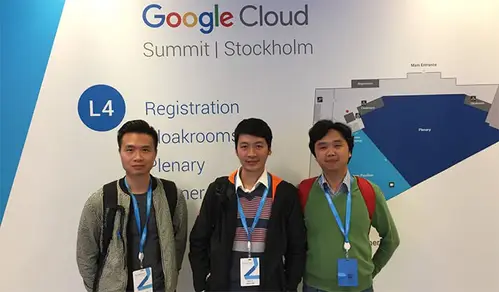2017 has brought us incredible feats of human ingenuity. Spectacular innovation such as the development of SpaceX’s reusable space rocket and the development of face recognition software that’s accurate enough to find widespread use in bank transactions in China. These days, technological advances are realized faster, meaning the ‘next big thing’ has become harder to predict.
However, some technologies will continue their prevalence into 2018 or step up to create major changes in the way we work, live, and shop. Businesses as well as consumers would do well to prepare, as we predict these seven technology trends for 2018:
AI and its risks
Artificial Intelligence will continue to play a big role in 2018, which will be a surprise to no one. The development and adoption of AI and machine learning will continue in the New Year and is highly likely to reach new heights. From virtual assistants to AI-assisted personalization schemes in CMS suites, intelligent applications are going to permeate many aspects of computing and everyday life.
This proliferation will also result in more worries about the future of AI. With tech greats like Elon Musk leading the charge in warning of the dangers inherent in the technology, expect critics to voice their concerns more openly.
IoT and its challenges for the Cloud
Like AI, the Internet of Things is not a completely new trend. However, you can expect 2018 to be its year. To many developers and decision makers alike, IoT is only a buzzword. However, companies wanting to make sure they are not left behind in this field should invest as soon as possible.
If you count smart phones, devices connected to the IoT already outnumber humans, and 2018 will send their number skyrocketing. This will mean an extreme increase in the amount of data produced and collected, putting a major strain on current cloud computing architectures. Learning how to deal with this data and how to use it efficiently will be a major challenge in the next few years.
Another risk associated with the Internet of Things is its vulnerability to hacker attacks. Criminals can exploit large networks to establish botnets, used for producing spam or for more sinister purposes. Network security will have to keep up so as not to provide a home for new and gigantic botnets.
Edge Computing
A direct result of the development in the Internet of Things is increased analytical and computing power that’s integrated in many machines that are not traditionally used in computing. As the IoT expands, we will create more and more of these devices. This means that, with the help of machine learning, some analyses and computing tasks can be done right at the source, without having to refer to the computing power at the network’s center, or in the cloud. They are done right there, at the ‘edge’ of the network, where data is actually created.
Expect growth in the IoT to go hand-in-hand with increased opportunities for edge computing. More intelligent machines means more machines are enabled to learn, compute, and analyze on their own, lessening the strain on data transfers as well as cloud computing power and storage capacities.
Talking to machines
Amazon’s Echo devices with their integrated virtual assistant Alexa paved the way, but several companies now offer speakers with voice-activated virtual inhabitants that take care of the little challenges of life. Their success shows that many people are dropping their reservations about talking to a machine. This is a trend that is likely to continue, with Amazon, Google and others now offering versions of their respective speakers for as little as 50 dollars. Becoming users’ go-to service is worth a lot of initial losses to these tech giants, as the market is still in its infancy. Market intelligence firm Tractica expects 1.8 billion people will use virtual assistants by 2021.
While it is likely that 2018 will be the year when the race for this market segment heats up for real, voice control is by no means limited to speakers with virtual assistants. With developers working out more and more of the kinks in the technology, we will start to see more voice control options for other devices, from computers and phones to cars.
Self-driving cars
No, 2018 will not be the year we get fully autonomous cars that become freely available on the market. However, we will take large steps in that direction. Both Tesla and GM can now produce cars with hardware that’s capable of full autonomy, on regular assembly lines. So now, we are waiting for the software to catch up with the hardware. Once the technology has a proven safety record in more extensive field tests, it can be approved by authorities. This will likely take a few more years.
However, we already see what this tech might have in store for us. Tesla only recently unveiled its latest prototype, an electric long-haul semi-truck equipped with all the company’s autonomy capabilities. While this is probably more of a proof of concept – it is unlikely that this market will adopt electric vehicles anytime soon and batteries would have to be extremely heavy – it shows that companies are doing consistent work to extend this segment.
The Machine
All of the trends above have been in the works for some time; most of them are logical consequences of what came before. What can’t always be predicted are real breakthroughs that propel human technology forward with sudden force. Quantum computing will be one of these breakthroughs, but we will have to wait for a few more years.
What is more tangible is HP’s latest prototype, conspicuously named ‘The Machine’. It houses a completely new kind of computer memory, which HP claims can store and instantly analyze a potentially limitless amount of data and calls the ‘first real change in computing in 70 years’. If this technology keeps what HP promises, it could usher in a major change for server technology. Everyone should keep an eye on it, as it might become available in 2018.
The mobile evolution
Internet traffic migrating from computers to mobile devices is hardly a new trend. What is fascinating and new, however, is the sheer scale of the evolution that is taking place. Already, mobile traffic has overtaken traffic from desktop or laptop computers. By 2020, traffic is expected to increase eightfold. This doesn’t mean that computer traffic will become obsolete. What it does mean is that now is the last chance for websites to get on board with the switch to mobile.
E-commerce will have to face this change head on, as 21 percent of e-commerce transactions are currently carried out using mobile devices. With mobile traffic increasing, this number will also rise significantly in 2018. So offering satisfying mobile experiences will become more important than ever in order to convert traffic into sales and to keep customers coming back.
As digital disruption looks to get more disruptive, make sure your company does not get left behind. Get in touch with us today to find out how new technology can be used in a bid to boost your bottom line.
to transform your business and drive results?



